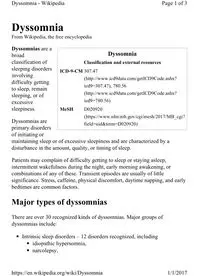
Dyssomnia-2017 PDF
Preview Dyssomnia-2017
Dyssomnia Classification and external resources ICD-9-CM 307.47 (http://www.icd9data.com/getICD9Code.ashx? icd9=307.47), 780.56 (http://www.icd9data.com/getICD9Code.ashx? icd9=780.56) MeSH D020920 (https://www.nlm.nih.gov/cgi/mesh/2017/MB_cgi? field=uid&term=D020920) Dyssomnia From Wikipedia, the free encyclopedia Dyssomnias are a broad classification of sleeping disorders involving difficulty getting to sleep, remain sleeping, or of excessive sleepiness. Dyssomnias are primary disorders of initiating or maintaining sleep or of excessive sleepiness and are characterized by a disturbance in the amount, quality, or timing of sleep. Patients may complain of difficulty getting to sleep or staying asleep, intermittent wakefulness during the night, early morning awakening, or combinations of any of these. Transient episodes are usually of little significance. Stress, caffeine, physical discomfort, daytime napping, and early bedtimes are common factors. Major types of dyssomnias There are over 30 recognized kinds of dyssomnias. Major groups of dyssomnias include: ◾ Intrinsic sleep disorders – 12 disorders recognized, including ◾ idiopathic hypersomnia, ◾ narcolepsy, Page 1 of 3 Dyssomnia - Wikipedia 1/1/2017 https://en.wikipedia.org/wiki/Dyssomnia ◾ periodic limb movement disorder, ◾ restless legs syndrome, ◾ sleep apnea, ◾ sleep state misperception. ◾ Extrinsic sleep disorders – 13 disorders recognized, including ◾ alcohol-dependent sleep disorder, ◾ food allergy insomnia, ◾ inadequate sleep routine. ◾ Circadian rhythm sleep disorders, both intrinsic and extrinsic – 6 disorders recognized, including ◾ advanced sleep phase syndrome, ◾ delayed sleep phase syndrome, ◾ jetlag, ◾ shift work sleep disorder. Treatment In general, there are two broad classes of treatment, and the two may be combined: psychological (cognitive-behavioral) and pharmacological. In situations of acute distress such as a grief reaction, pharmacologic measures may be most appropriate. With primary insomnia, however, initial efforts should be psychologically based, including discussion of good sleep hygiene. Other specific treatments are appropriate for some of the disorders, such as ingestion of the hormone melatonin, correctly timed bright light therapy and correctly timed dark therapy or light restriction for the circadian rhythm sleep disorders. Specialists in sleep medicine are trained to diagnose and treat these disorders, though many specialize in just some of them. See also ◾ Somnolence ◾ Parasomnia ◾ Dyskoimesis Page 2 of 3 Dyssomnia - Wikipedia 1/1/2017 https://en.wikipedia.org/wiki/Dyssomnia Retrieved from "https://en.wikipedia.org/w/index.php? title=Dyssomnia&oldid=711122231" Categories: Sleep disorders ◾ This page was last modified on 21 March 2016, at 00:50. ◾ Text is available under the Creative Commons Attribution-ShareAlike License; additional terms may apply. By using this site, you agree to the Terms of Use and Privacy Policy. Wikipedia® is a registered trademark of the Wikimedia Foundation, Inc., a non-profit organization. Page 3 of 3 Dyssomnia - Wikipedia 1/1/2017 https://en.wikipedia.org/wiki/Dyssomnia
